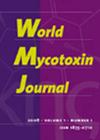荷兰总饮食研究中1岁和2岁儿童对真菌毒素的饮食暴露
IF 1.7
4区 医学
Q3 FOOD SCIENCE & TECHNOLOGY
引用次数: 7
摘要
2017年,在荷兰进行了一项总饮食研究,分析了1岁和2岁儿童食用的食品和饮料中的真菌毒素。这些真菌毒素是黄曲霉毒素、交替菌毒素、柑桔毒素、麦角生物碱、伏马毒素、赭曲霉毒素A、展曲霉素、sterigmatocystin、曲霉烯和玉米赤霉烯酮。通过将食品和饮料中的浓度与这些产品的消费量相结合来计算长期暴露量。经分析的食品和饮料的浓度低于可能含有霉菌毒素的检测限,其浓度等于该极限值的一半。为了评估暴露是否可能导致健康风险,将高长期暴露(第95百分位)与基于健康的指导值(HBGV)或暴露边际(MOE)进行比较。接触黄曲霉毒素、交替菌毒素、赭曲霉毒素A和T-2/HT-2可能会造成健康问题。最容易接触这些真菌毒素的食物是面包、饼干、早餐谷物、巧克力、干果、后续配方奶粉和果汁。本文章由计算机程序翻译,如有差异,请以英文原文为准。
Dietary exposure to mycotoxins of 1- and 2-year-old children from a Dutch Total Diet Study
In 2017, a Total Diet Study was conducted in the Netherlands in which mycotoxins were analysed in foods and beverages consumed by 1- and 2-year-old children. These mycotoxins were aflatoxins, Alternaria toxins, citrinin, ergot alkaloids, fumonisins, ochratoxin A, patulin, sterigmatocystin, trichothecenes, and zearalenone. Long-term exposure was calculated by combining concentrations in foods and beverages with consumed amounts of these products. Analysed foods and beverages with a concentration below the detection limit that could contain the mycotoxin, were assigned a concentration equal to half this limit value. To assess if the exposure could result in a possible health risk, the high long-term exposure (95th percentile) was compared with a health-based guidance value (HBGV) or a margin of exposure (MOE) was calculated. Exposure to aflatoxins, Alternaria toxins, ochratoxin A and T-2/HT-2 sum may pose a health concern. Foods that contributed most to the exposure of these mycotoxins were bread, biscuits, breakfast cereals, chocolates, dried fruit, follow-on formula and fruit juices.
求助全文
通过发布文献求助,成功后即可免费获取论文全文。
去求助
来源期刊

World Mycotoxin Journal
MYCOLOGY-
CiteScore
4.60
自引率
5.00%
发文量
25
审稿时长
>12 weeks
期刊介绍:
''World Mycotoxin Journal'' is a peer-reviewed scientific journal with only one specific area of focus: the promotion of the science of mycotoxins. The journal contains original research papers and critical reviews in all areas dealing with mycotoxins, together with opinions, a calendar of forthcoming mycotoxin-related events and book reviews. The journal takes a multidisciplinary approach, and it focuses on a broad spectrum of issues, including toxicology, risk assessment, worldwide occurrence, modelling and prediction of toxin formation, genomics, molecular biology for control of mycotoxigenic fungi, pre-and post-harvest prevention and control, sampling, analytical methodology and quality assurance, food technology, economics and regulatory issues. ''World Mycotoxin Journal'' is intended to serve the needs of researchers and professionals from the scientific community and industry, as well as of policy makers and regulators.
 求助内容:
求助内容: 应助结果提醒方式:
应助结果提醒方式:


